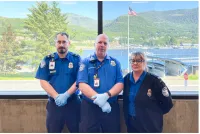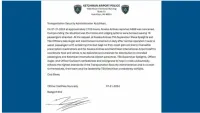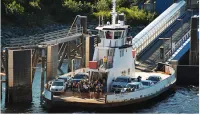 Ketchikan Airport Borough ferry. (TSA stock image)
Ketchikan Airport Borough ferry. (TSA stock image)
Traveling in Alaska has its challenges. Whether you are mushing a dog sled in The Bush, driving on the icy roads of the panhandle, white knuckling the frigid snow-packed roads of Fairbanks or cruising on the Alaska Marine Highway; they can all be a wilderness adventure.
So when an evening flight from Seattle to Juneau was cancelled, stranding 16 passengers, it was just business as usual at Ketchikan International Airport (KTN).
KTN airport is located on Gravina Island, west of the city of Ketchikan, and on the other side of the Tongrass Narrows. There is no direct road access to the airport. Passengers, airline staff, airport workers and TSA Officers rely on a local ferry operated by the Ketchikan Airport Borough for the seven-minute ride to the airport. Running on the hour and every 30 minutes, the locals know, if you miss the ferry, you could miss your flight or be late for work.
The ferry didn’t figure into the Alaska Airlines (AA) mechanical cancellation (needing a part flown in from Seattle) but the chain-reaction cancellations, coupled with the lack of lodging at the height of tourist season and the annual salmon run, figured in mightily, leaving the passengers stranded at the airport to spend the night.
As word spread that the passengers would have to bivouac in-place, the KTN Officers organized, put their heads together and developed a plan.
Reporting for duty that morning, Supervisory TSA Ofiicer (STSO) Steve Speights and TSA Officers (TSO) Jake Auger and Lisa Carlson all volunteered and worked well beyond their shifts to accommodate the stranded passengers.
First step of the plan was for the Alaska Airlines (AA) ground crew to unload the plane of all passenger baggage and TSA KTN crew reverse screened the luggage. “People needed their medication and personal effects if they were to remain in the terminal overnight,” said TSO Lisa Carlson. “Everyone was very appreciative.”
Next, AA brought in blankets and pillows for the stranded group that were to remain the night in the sterile area of the terminal. “Several of the children made blanket forts as they settled in for the long night,” recalls Carlson.
“AA brought in food that had to be screened before it could move into the sterile area,” said STSO Speights. “We ordered pizza from a couple of the local food stores, but they didn’t arrive until about 12:30 a.m.—it was going to be a long night.”
Everyone pitched in to help; Alaska Airlines employees, KTN Airport Police, TSA and the town of Ketchikan.
“It is fantastic the way small towns support the smaller airports,” said Auger. “So, it wasn’t just bare bones support, we provided a lot of extras to these stranded passengers.”
“The selflessness and commitment shown by STSO Speights, Officer Auger and Officer Carlson are exemplary of the highest standards of the Transportation Security Administration,” stated TSA Manager Jeremiah Tucker. “Their actions not only provided critical assistance during a difficult time but also highlighted the outstanding leadership and teamwork consistently demonstrated by TSA Ketchikan.”
In a letter of commendation, Ketchikan Airport Police Officer Matthew Nunnally said, “TSA Supervisor Speights, Officers Auger and Carlson’s selflessness and willingness to help in a crisis undoubtedly reflects the highest standards of the Transportation Security Administration and is a credit to themselves, their team and the leadership TSA Ketchikan consistently exhibits.”



